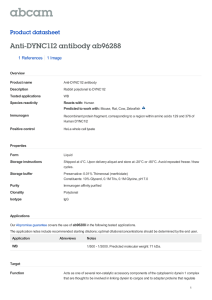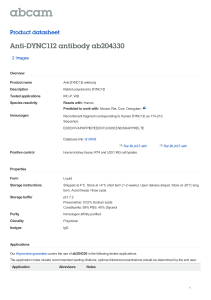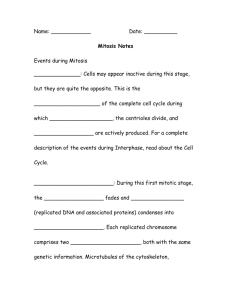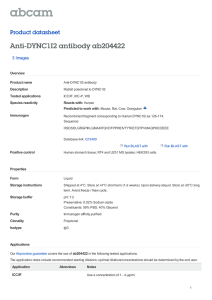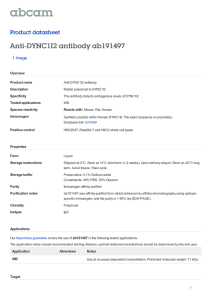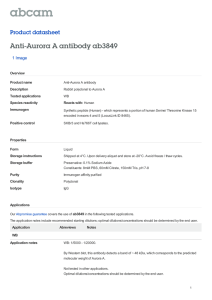Kayla Gandy Poster
advertisement
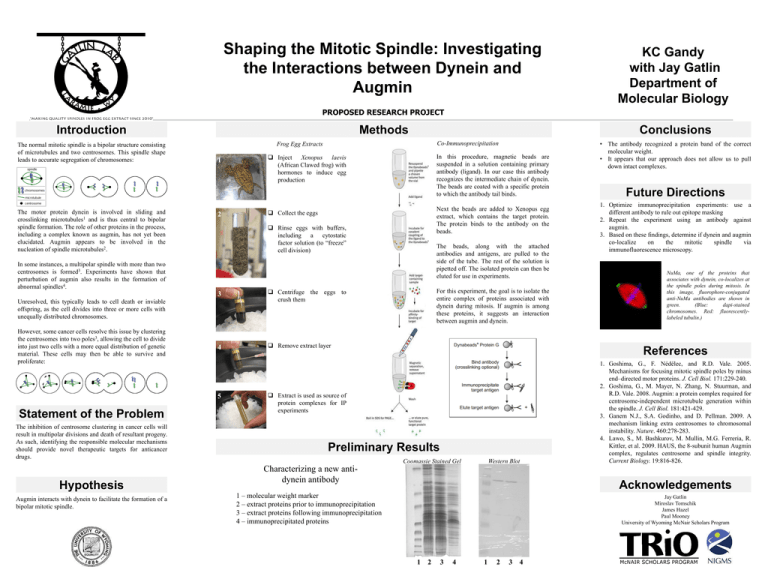
Shaping the Mitotic Spindle: Investigating the Interactions between Dynein and Augmin KC Gandy with Jay Gatlin Department of Molecular Biology PROPOSED RESEARCH PROJECT Introduction The normal mitotic spindle is a bipolar structure consisting of microtubules and two centrosomes. This spindle shape leads to accurate segregation of chromosomes: The motor protein dynein is involved in sliding and crosslinking microtubules1 and is thus central to bipolar spindle formation. The role of other proteins in the process, including a complex known as augmin, has not yet been elucidated. Augmin appears to be involved in the nucleation of spindle microtubules2. Methods 1 2 Hypothesis Augmin interacts with dynein to facilitate the formation of a bipolar mitotic spindle. In this procedure, magnetic beads are suspended in a solution containing primary antibody (ligand). In our case this antibody recognizes the intermediate chain of dynein. The beads are coated with a specific protein to which the antibody tail binds. Next the beads are added to Xenopus egg extract, which contains the target protein. The protein binds to the antibody on the beads. Collect the eggs 3 Centrifuge the eggs to crush them 4 Remove extract layer 5 The inhibition of centrosome clustering in cancer cells will result in multipolar divisions and death of resultant progeny. As such, identifying the responsible molecular mechanisms should provide novel therapeutic targets for anticancer drugs. Inject Xenopus laevis (African Clawed frog) with hormones to induce egg production Rinse eggs with buffers, including a cytostatic factor solution (to “freeze” cell division) Unresolved, this typically leads to cell death or inviable offspring, as the cell divides into three or more cells with unequally distributed chromosomes. Statement of the Problem Co-Immunoprecipitation Frog Egg Extracts In some instances, a multipolar spindle with more than two centrosomes is formed3. Experiments have shown that perturbation of augmin also results in the formation of abnormal spindles4. However, some cancer cells resolve this issue by clustering the centrosomes into two poles3, allowing the cell to divide into just two cells with a more equal distribution of genetic material. These cells may then be able to survive and proliferate: Conclusions The beads, along with the attached antibodies and antigens, are pulled to the side of the tube. The rest of the solution is pipetted off. The isolated protein can then be eluted for use in experiments. For this experiment, the goal is to isolate the entire complex of proteins associated with dynein during mitosis. If augmin is among these proteins, it suggests an interaction between augmin and dynein. • The antibody recognized a protein band of the correct molecular weight. • It appears that our approach does not allow us to pull down intact complexes. Future Directions 1. Optimize immunoprecipitation experiments: use a different antibody to rule out epitope masking 2. Repeat the experiment using an antibody against augmin. 3. Based on these findings, determine if dynein and augmin co-localize on the mitotic spindle via immunofluorescence microscopy. NuMa, one of the proteins that associates with dynein, co-localizes at the spindle poles during mitosis. In this image, fluorophore-conjugated anti-NuMa antibodies are shown in green. (Blue: dapi-stained chromosomes. Red: fluorescentlylabeled tubulin.) References Extract is used as source of protein complexes for IP experiments Preliminary Results Coomassie Stained Gel Western Blot Characterizing a new antidynein antibody 1. Goshima, G., F. Nédélec, and R.D. Vale. 2005. Mechanisms for focusing mitotic spindle poles by minus end–directed motor proteins. J. Cell Biol. 171:229-240. 2. Goshima, G., M. Mayer, N. Zhang, N. Stuurman, and R.D. Vale. 2008. Augmin: a protein complex required for centrosome-independent microtubule generation within the spindle. J. Cell Biol. 181:421-429. 3. Ganem N.J., S.A. Godinho, and D. Pellman. 2009. A mechanism linking extra centrosomes to chromosomal instability. Nature. 460:278-283. 4. Lawo, S., M. Bashkurov, M. Mullin, M.G. Ferreria, R. Kittler, et al. 2009. HAUS, the 8-subunit human Augmin complex, regulates centrosome and spindle integrity. Current Biology. 19:816-826. Acknowledgements 1 – molecular weight marker 2 – extract proteins prior to immunoprecipitation 3 – extract proteins following immunoprecipitation 4 – immunoprecipitated proteins Jay Gatlin Miroslav Tomschik James Hazel Paul Mooney University of Wyoming McNair Scholars Program 1 2 3 4 1 2 3 4
